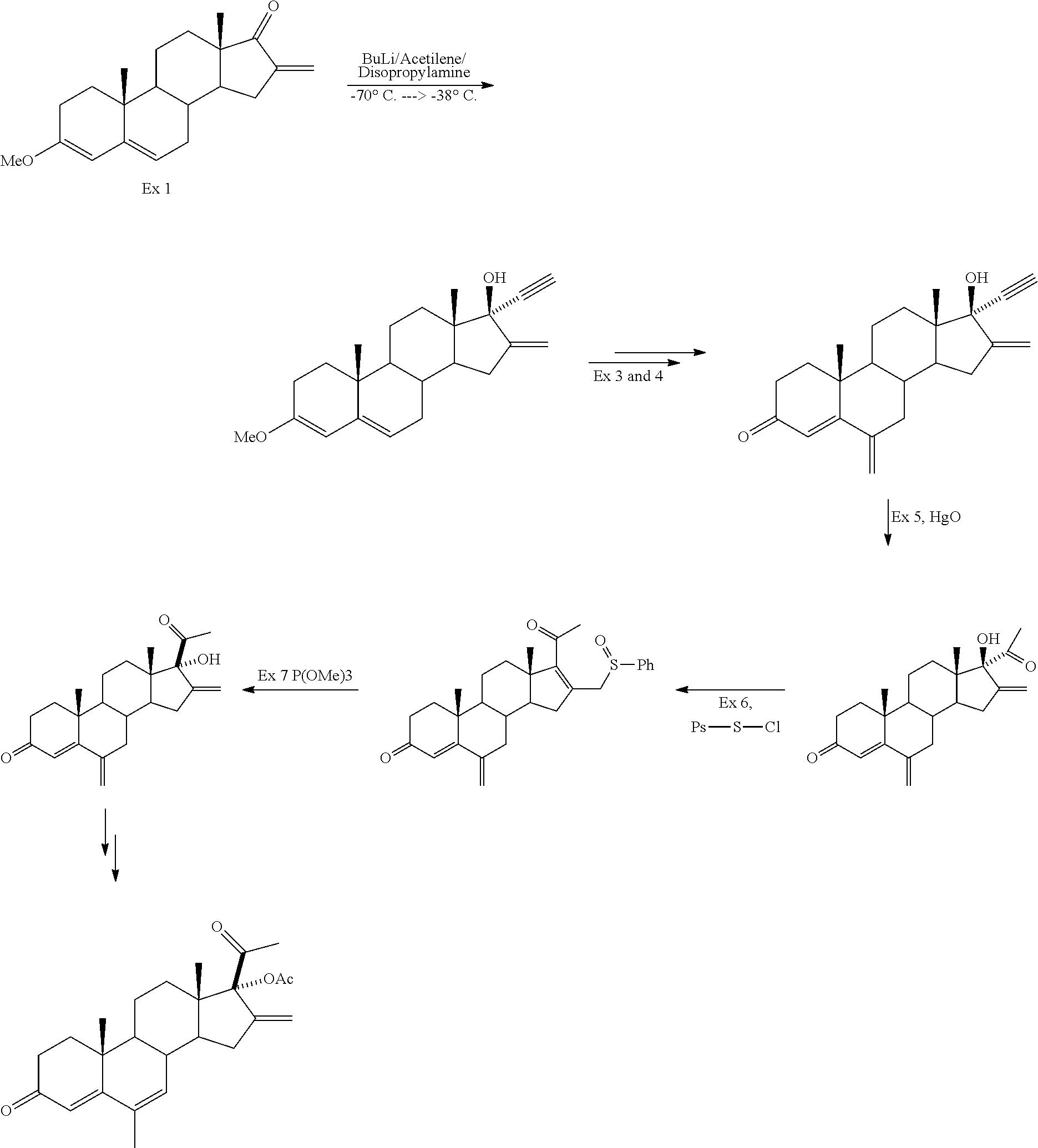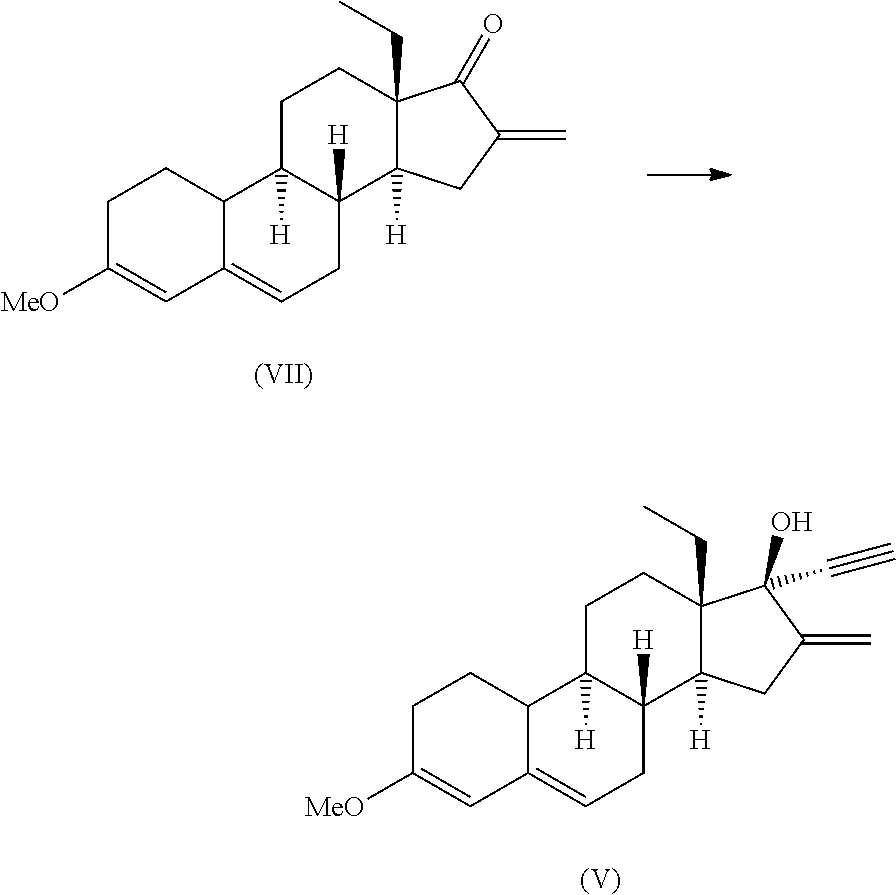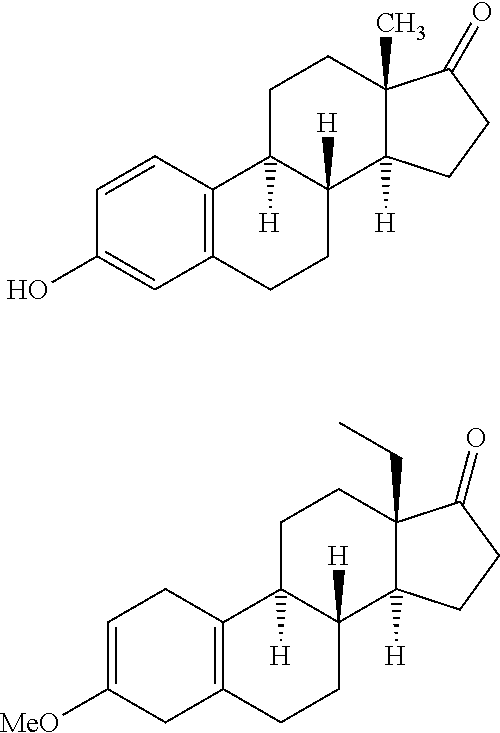Process for alkynylating 16-substituted-17-keto steroids
a technology of ethylated 16methylene17keto steroids and ethylated 16methylene17keto steroids, which is applied in the preparation of steroids, steroidoids, organic chemistry, etc., can solve the problems of reduced reactivity, formation of different impurities, and low yield (less than 50%) and achieve high yield and high purity
- Summary
- Abstract
- Description
- Claims
- Application Information
AI Technical Summary
Benefits of technology
Problems solved by technology
Method used
Image
Examples
example 1
Synthesis of 3-ethoxy-16-methylene-18-methyl-19-norandrosta-3,5-dien-17-one (3)
[0181]
[0182]Enol ether (2) was prepared by reacting 19-norandrostendione (1) with trimethyl orthoformate in THF under acid catalysis. Compound (2) was not isolated, but used directly in the next step.
[0183]Compound (3) was obtained by treating enol ether (2) with diethyl oxalate and a base. Both sodium methoxide and sodium ethoxide have been used as the base, affording reaction completion in about an hour. Then, acetic acid, methanol and triethylamine and aqueous formaldehyde were added to the reaction mixture. The reaction was carried out at 0° C. and was complete in about 2 hours (WO 97 / 23498 discloses that this reaction is preferably performed at 0° C., however it has been observed that the reaction proceeds at lower temperature, such as 0° C., affording the desired product with fewer impurities). Then, water was added and the solvent was evaporated under vacuum. The resulting solid was filtered, washe...
example 2
Synthesis of 3-ethoxy-16-methylene-17α-ethynyl-17β-hydroxy-18-methyl-19-norandrosta-3,5-diene (4)
[0185]
[0186]24.5 mL of THF were added to a round-bottom flask under inert atmosphere and cool to −5 / −10° C. Then, trimethylsilylacetylene (1.6 equiv.) was added followed by dropwise addition of HMDSLi 1.3 M (1.8 equiv.).
[0187]The mixture was stirred at −5 / −10° C. for 30 minutes. Then, a solution of compound 3 (9.74 g) in THF (39 mL) was added at the same temperature. When the reaction was complete, 49 mL of metanol and 2.14 g of potassium carbonate (0.5 equiv.) dissolved in 13.5 mL of water were added. Temperature was increased to 20-25° C. until the reaction was complete. 29 mL of water were added, and the solvents distilled under vacuum. The resulting solid was filtered, washed with 20 mL of water and dried at 50° C., giving rise to compound 4 in 92% yield.
example 3
Synthesis of 16-methylene-17α-acetyl-17β-hydroxy-18-methyl-19-norandrosta-4-en-3-one (6)
[0188]
[0189]Compound (5) was obtained by treating a solution of compound (4) in acetone with a solution of sulphuric acid and HgO in water. Intermediate (5) was formed by hydrolysis of the enol ether and, without isolation, it was maintained at 65° C. for 1 hour to give rise to the hydration of the ethynyl group to methylketone. When the reaction was complete, mercury salts were removed. The reaction mixture was neutralized with ammonia, water was added and acetone was evaporated under vacuum. The mixture was extracted with CH2Cl2, treated with acetic acid and Zn to remove mercury residues.
[0190]Compound (6) was isolated with high purity (more than 99% by HPLC), so that further purification is not needed.
PUM
| Property | Measurement | Unit |
|---|---|---|
| temperature | aaaaa | aaaaa |
| temperature | aaaaa | aaaaa |
| temperature | aaaaa | aaaaa |
Abstract
Description
Claims
Application Information
 Login to View More
Login to View More - R&D
- Intellectual Property
- Life Sciences
- Materials
- Tech Scout
- Unparalleled Data Quality
- Higher Quality Content
- 60% Fewer Hallucinations
Browse by: Latest US Patents, China's latest patents, Technical Efficacy Thesaurus, Application Domain, Technology Topic, Popular Technical Reports.
© 2025 PatSnap. All rights reserved.Legal|Privacy policy|Modern Slavery Act Transparency Statement|Sitemap|About US| Contact US: help@patsnap.com



